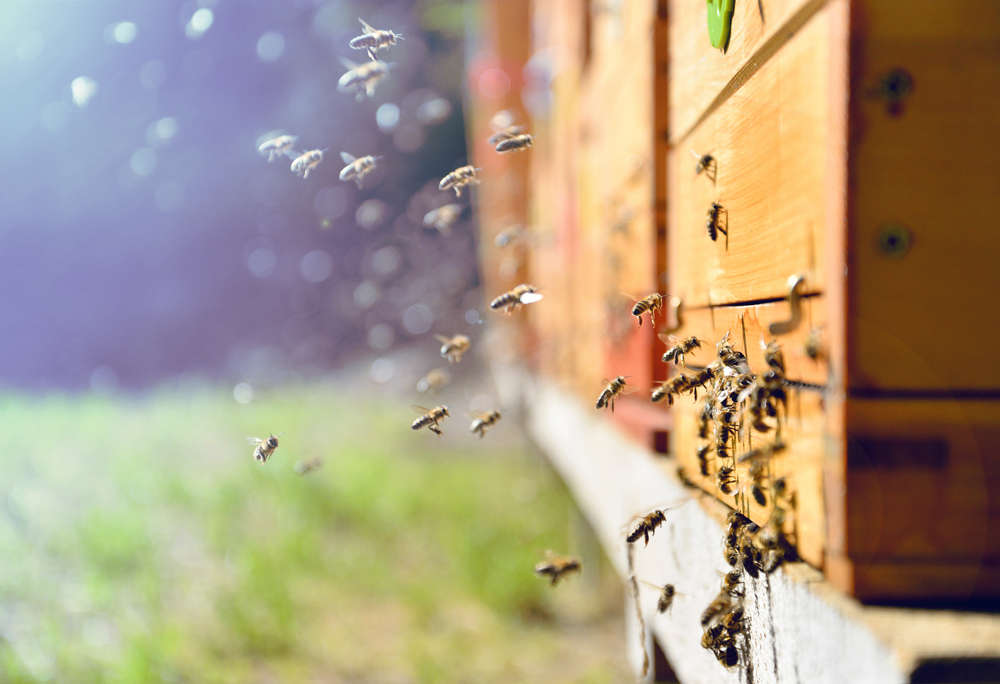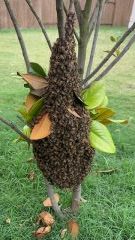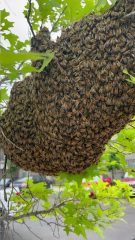
Why Do Honey Bees Swarm?
Written by: Keith Huddle
May 9, 2024Have you ever witnessed a swirling mass of bees hanging from a tree branch or clustered on an unusual spot? This fascinating phenomenon is known as swarming, a crucial event in the life cycle of honey bees. Swarming is not just a spectacle; it’s a vital process by which beehives reproduce and perpetuate their species.
What is Bee Swarming?

Swarms are how beehives reproduce and are both intimidating and amazing to see. Thousands of bees leave a hive in search of a new location to build a new hive. After leaving the original hive, they typically land on a tree branch about 8 to 15 feet high. While they do occasionally pick weird locations like under car tires or on the sides of buildings, it’s typically a tree. While they rest on the tree, their goal is to find a place to move into. They need structure to build their hive into and typically don’t build in the open.
The Reproductive Drive of Bees

The primary reason behind swarming lies in the reproductive nature of honey bee colonies. When a hive becomes overcrowded, usually in the spring or early summer, with a thriving population and limited space, the bees prepare for swarming. The existing queen, along with a significant portion of worker bees, departs the hive to establish a new colony. This process helps the original hive avoid overcrowding and provides an opportunity for the species to propagate.
Finding a New Home

During the swarm resting time on the tree, they don’t have a home to defend and they don’t have an actual storage of food or babies to defend so they have no reason to be aggressive. That can all change once the hive has chosen a spot to live and build in, and they begin to increase their numbers. Inside the cluster of bees known as the swarm, there is one queen that can actually lay eggs while all the others cannot, so they are very protective of her. Until they move in, she’s more worried about finding a home to hide in and not really going to give the attack signal.

The Calm Before the Storm
If you encounter a swarm of bees, there’s usually not much to worry about initially. While they’re in this state, they are typically very calm and easy to capture for relocation. However, left on their own within about 24 to 48 hours, they will find a location to move into and start building their new hive. At this point, their behavior can change as they become more defensive of their new territory.
Importance of Bee Swarms
Despite their potentially intimidating appearance, bee swarms are essential for the health and survival of honey bee populations. They contribute to genetic diversity within bee colonies and enable the expansion of bee populations into new areas. Additionally, swarming plays a critical role in pollination, benefiting agricultural crops and wild plant species.
 Addressing Concerns
Addressing Concerns
So, why do bees swarm? It’s a natural process driven by the need for honey bee colonies to reproduce and expand. If you encounter a swarm, remember that they are typically focused on finding a suitable home rather than posing a threat. It’s advisable to contact a local beekeeper or bee removal expert to safely relocate the swarm, benefiting both the bees and our ecosystem.
Summary
The sight of a bee swarm is not just a marvel of nature but a testament to the intricate reproductive cycle of honey bees. Understanding why bees swarm helps us appreciate their role in the environment and underscores the importance of conservation efforts to protect these invaluable pollinators.
Need Bee Removal Services in Austin, TX?
Here at Keith’s Bee Service, we understand the importance of safely managing bee swarms for both bees and our community. If you come across a bee swarm, don’t panic. Instead, reach out to us for professional bee swarm relocation services! We specialize in safely relocating swarms to ensure the well-being of these vital pollinators and to safeguard our environment. Contact us today to assist with any bee-related concerns!
Categorized in: Bee Control Services
